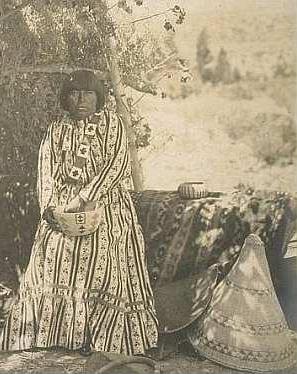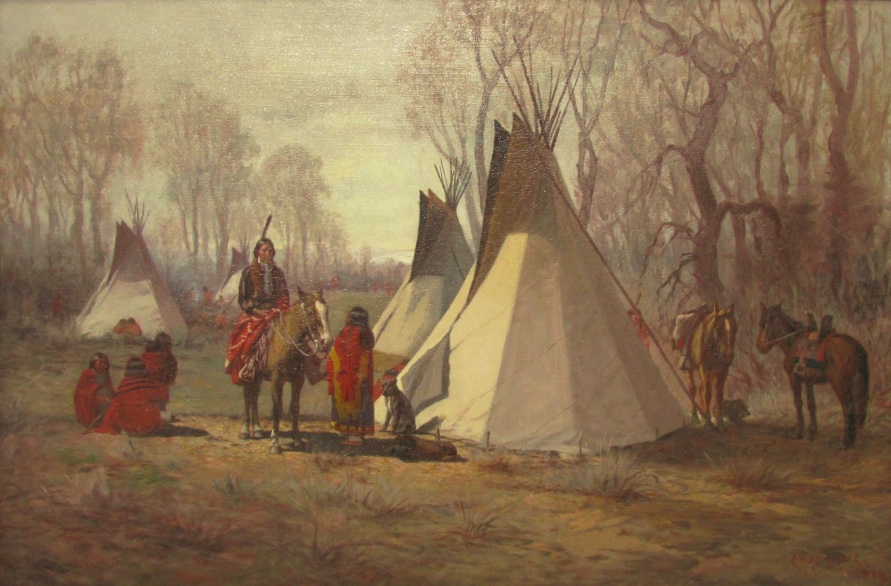|
Native American Artists
This is a list of visual artists who are Native Americans in the United States. The Indian Arts and Crafts Act of 1990 defines "Native American" as being enrolled in either federally recognized tribes or state recognized tribes or "an individual certified as an Indian artisan by an Indian Tribe." This does not include non-Native American artists using Native American themes. Additions to the list need to reference a recognized, documented source and specifically name tribal affiliation according to federal and state lists. Indigenous American artists outside the United States can be found at List of indigenous artists of the Americas. Basket makers * Elsie Allen, Cloverdale Rancheria of Pomo Indians of California, Cloverdale Pomo * Annie Antone, Tohono O'odham * Mary Knight Benson, Pomo, (1877–1930) * William Ralganal Benson, Pomo, (1862–1937) * Carrie Bethel, Mono Lake Paiute * Susan Billy, Hopland Band of Pomo Indians of the Hopland Rancheria, Hopland Band Pomo * Mary ... [...More Info...] [...Related Items...] OR: [Wikipedia] [Google] [Baidu] |
Dextra Quotskuyva
Dextra Quotskuyva Nampeyo (September 6, 1928 – February 2019) was a Indigenous peoples of the Americas, Native American potter and artist. She was in the fifth generation of a distinguished ancestral line of Hopi potters. In 1994 Dextra Quotskuyva was proclaimed an "Arizona Living Treasure," and in 1998 she received the first Arizona State Museum Lifetime Achievement Award.Dextra Quotskuyva at Holmes Museum of Anthropology In 2001, the Wheelwright Museum organized a 30-year retrospective exhibition of Quotskuyva's pottery, and in 2004, she received the Southwestern Association for Indian Arts Lifetime Achievement award. Personal life Quotskuyva was the great-granddaughter of Hopi people, Hopi-Tewa people, Tewa potter Nampeyo, Nampeyo of Hano, who revive ...[...More Info...] [...Related Items...] OR: [Wikipedia] [Google] [Baidu] |
Mono Lake Paiute
The Kucadɨkadɨ are a band of Eastern Mono Northern Paiute people who live near Mono Lake in Mono County, California. They are the southernmost band of Northern Paiute.Fowler and Liljeblad 437Arkush, Brooke S"Historic Northern Paiute Winter Houses in Mono Basin, California."''Journal of California and Great Basin Anthropology''. 9 (2) 1987 (retrieved August 31, 2010) Name Kucadɨkadɨ means "eaters of the brine fly pupae". They are also known as the Kutsavidökadö, Koza'bittukut'teh, Kotsa'va, Mono Lake Paiute, Mono Basin Paiute, and Kuzedika, while the tribe itself calls themselves Kootzaduka’a. The term "Mono Lake Paiute," a holdover from early anthropological literature, has proven problematic. The term "Mono" is from a Yokutsan loanword from the tribe's southwestern neighbors, the Yokuts, who designated the band living around Mono Lake as ''monachie/monoache'' (" fly people") because fly larvae were their chief food staple and trading article. Later researchers believed t ... [...More Info...] [...Related Items...] OR: [Wikipedia] [Google] [Baidu] |
Gun Lake Potawatomi
The Match-e-be-nash-she-wish Band of Pottawatomi Indians of Michigan is a federally recognized tribe of Potawatomi people in Michigan named for a 19th-century Ojibwe chief. They were formerly known as the Gun Lake Band of Grand River Ottawa Indians, the United Nation of Chippewa, Ottawa and Pottawatomi Indians of Michigan, Inc.,Petition for Federal Acknowledgment of Match-e-be-nash-she-wish Band of Pottawatomi Indians of Michigan William L. Church, May 16, 1994. and the Gun Lake Tribe or Gun Lake Band."Tribal Council" ''Match-e-be-nash-she-wish Band of Pottawatomi.'' (retrieved 18 Dec 2009) ... [...More Info...] [...Related Items...] OR: [Wikipedia] [Google] [Baidu] |
Kelly Church
Kelly Jean Church ( Match-e-benash-she-wish Potawatomi/Odawa/Ojibwe) is a black ash basket maker, Woodlands style painter, birchbark biter, and educator. She lives in Michigan. Background Kelly Jean Church, a fifth-generation basket maker, was born in 1967. She grew up in southwestern Michigan. Her mother is of English and Irish heritage, and her father is of Potawatomi, Odawa, and Ojibwe heritage. Church studied the Odawa language from her paternal grandmother and learned black ash basketry from her father, Bill Church, and cousin, John Pigeon. She, in turn, has taught her daughter, Cherish Parrish ( Gun Lake Band Potawatomi). Church has completed an AFA degree at the Institute of American Indian Studies and a BFA degree at the University of Michigan. Artwork Basketry Along with her family, Church harvests her own trees in swampy areas of rural Michigan. Preparing the materials takes far longer than the weaving. She removes the bark from the felled log and then splits apart ... [...More Info...] [...Related Items...] OR: [Wikipedia] [Google] [Baidu] |
Uncompahgre Ute
The Uncompahgre Ute () or ꞌAkaꞌ-páa-gharʉrʉ Núuchi (also: Ahkawa Pahgaha Nooch) is a band of the Ute people, Ute, a Native American tribe located in the US states of Colorado and Utah. In the Ute language, means "rocks that make water red." The band was formerly called the Tabeguache. Tabeguache The Tabeguache (Ute dialect, Ute language: , ,, and ), or “People of Sun Mountain,” was the largest of the ten nomadic bands of the Ute and part of the Northern Ute People. They lived in river valleys of the Gunnison River and Uncompahgre River between the Parianuche to the north and the Weeminuche to the south. They traveled seasonally. Like other Ute, they were hunters who followed and hunted buffalo, deer, and elk. They moved their camp about every month, and created a link to Mother Earth at each camp by constructing a medicine wheel at the center of camp. The Tabeguache believed that the Pikes Peak, Pikes Peak region is their home. Their name for the mountain is , mea ... [...More Info...] [...Related Items...] OR: [Wikipedia] [Google] [Baidu] |
Chipeta
Chipeta or White Singing Bird (1843 or 1844 – August 9, 1924) was a Native American leader, and the second wife of Chief Ouray of the Uncompahgre Ute tribe. Born a Kiowa Apache, she was raised by the Utes in what is now Conejos, Colorado. An advisor and confidant of her husband, Chipeta continued as a leader of her people after his death in 1880. She was an Indian rights advocate and diplomat. She used diplomacy to try to achieve peace with the white settlers in Colorado. In 1985, Chipeta was inducted into Colorado Women's Hall of Fame for her "courage and valor she demonstrated in her efforts to mediate between Native Americans and whites." Personal life Chipeta, also known as "White Singing Bird", was born into the Kiowa Apache tribe in about 1843. She was adopted and raised by the Uncompahgre Utes in what is now Conejos, Colorado. She learned their traditional ways and became a skilled artisan in beadwork, tanning and making garments, like dresses, shirts, moccasins, ... [...More Info...] [...Related Items...] OR: [Wikipedia] [Google] [Baidu] |
Nellie Charlie
Nellie Charlie (1867–1965) was a Mono Lake Paiute - Kucadikadi basketmaker associated with Yosemite National Park. She was born in Lee Vining, California, the daughter of tribal headman Pete Jim, and his wife Patsy, also a basket maker. She married Young Charlie, a Mono Lake Paiute - Kucadikadi man from Yosemite, and they had six children. Her Paiute name was Besa-Yoona. Early life Nellie Charlie was born in 1867 in Lee Vining, California. She was the daughter of tribal headman Pete Jim and his wife, Patsy, who was also a skilled basketmaker. She grew up within the Mono Lake Paiute-Kucadikadi community, where she learned the art of traditional basket weaving from her mother. Personal life She married Young Charlie, a Mono Lake Paiute-Kucadikadi man from Yosemite, and the couple had six children. Her Paiute name was Besa-Yoona. Basket Weaving and Career Charlie was known for her work in both traditional and modern basket styles. She actively participated in the ann ... [...More Info...] [...Related Items...] OR: [Wikipedia] [Google] [Baidu] |
Smith River Tolowa
The Tolowa Dee-ni' Nation, previously known as Smith River Rancheria, is a federally recognized tribe of Tolowa people in Del Norte County, California."Smith River Rancheria." ''SDSU: California Indians and Their Reservations.'' Retrieved 4 June 2012. They are people, distantly related to northern Athabascans of eastern and western , as well as the [...More Info...] [...Related Items...] OR: [Wikipedia] [Google] [Baidu] |
Loren Bommelyn
Loren Me’-lash-ne Bommelyn (born 1956) is a tradition bearer for the Tolowa tribe. He has dedicated himself to preserving the traditional songs, language, and basketry. He is the foremost ceremonial leader of the tribe, and its most prolific basketweaver. Bommelyn is an enrolled member of the federally recognized Tolowa Dee-ni' Nation and was elected as their tribal chairperson. Work in linguistics and education Loren Bommelyn is Tolowa, Karuk, and Wintu. His mother, Eunice Bommelyn, was a prominent tribal genealogist, Tolowa language proponent and cultural advocate. He is a fluent speaker of the Tolowa language and taught for many years at Del Norte High School in Crescent City, California.Bibby, Brian. ''The Fine Art of California Indian Basketry.'' Sacramento: Crocker Art Museum, 1996: 51-52. . He earned his master's degree in linguistics from the University of Oregon. After years of studying with Tolowa elders, Bommelyn has published educational material about the Tolow ... [...More Info...] [...Related Items...] OR: [Wikipedia] [Google] [Baidu] |
Navajo
The Navajo or Diné are an Indigenous people of the Southwestern United States. Their traditional language is Diné bizaad, a Southern Athabascan language. The states with the largest Diné populations are Arizona (140,263) and New Mexico (108,305). More than three-quarters of the Diné population resides in these two states.American Factfinder The overwhelming majority of Diné are enrolled in the . Some Diné are enrolled in th ... [...More Info...] [...Related Items...] OR: [Wikipedia] [Google] [Baidu] |
Sally Black
Sally Black (born 1959, or 1962) is a Diné (Navajo) basketry artist. She lives in Monument Valley, and is an enrolled member of the Navajo Nation. Early life Sally Black was born in either 1959, or 1962. She is the daughter of the weaver and basketry artist, Mary Holiday Black. She was brought up on the Douglas Mesa in southeastern Utah. When she was eight years old she began weaving baskets, having learned the skills from her mother and grandmother. At age 15 she sold her first basket; it was bought by the Heard Museum in Phoenix. Work Sumac is the primary fiber she works with in both her pictorial and traditional baskets. She gathers the sumac from areas around the Green River and Hanksville, Utah. She then splits the fiber by hand, and dyes it. She spends most of the winter months for the actual weaving. In the 1970s she broke with tradition and began incorporating imagery into her basket designs including hummingbirds and eagles. Black has received honors and awards for her ... [...More Info...] [...Related Items...] OR: [Wikipedia] [Google] [Baidu] |
Navajo Nation
The Navajo Nation (), also known as Navajoland, is an Indian reservation of Navajo people in the United States. It occupies portions of northeastern Arizona, northwestern New Mexico, and southeastern Utah. The seat of government is located in Window Rock, Arizona. At roughly , the Navajo Nation is the largest Indian reservation in the United States, exceeding the size of List of U.S. states and territories by area, ten U.S. states. It is one of the few reservations whose lands overlap the nation's traditional homelands. In 2010, the reservation was home to 173,667 out of 332,129 Navajo tribal members; the remaining 158,462 tribal members lived outside the reservation, in urban areas (26%), border towns (10%), and elsewhere in the U.S. (17%). In 2020, the number of tribal members increased to 399,494, surpassing the Cherokee Nation as the largest tribal group by enrollment. The U.S. Mexican Cession, gained ownership of what is today Navajoland in 1848 following the Mexican–A ... [...More Info...] [...Related Items...] OR: [Wikipedia] [Google] [Baidu] |





